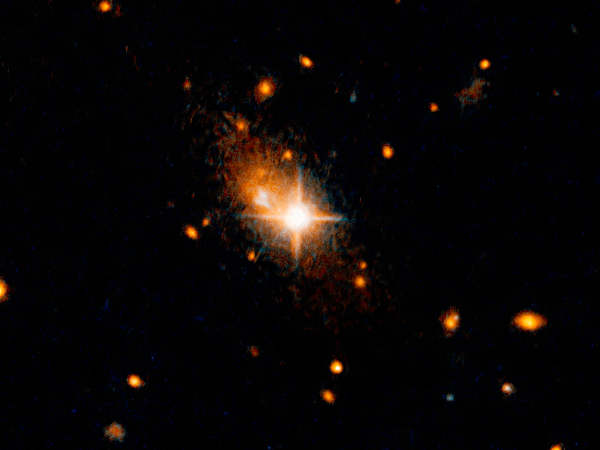Hubble detects supermassive black hole kicked out of galactic core - Astronomers suspect gravitational waves [heic1706]
23 March 2017
An international team of astronomers using the NASA/ESA Hubble Space Telescope have uncovered a supermassive black hole that has been propelled out of the centre of the distant galaxy 3C 186. The black hole was most likely ejected by the power of gravitational waves. This is the first time that astronomers found a supermassive black hole at such a large distance from its host galaxy centre. |
| Galaxy with an ejected supermassive black hole. Credit: NASA, ESA, and M. Chiaberge (STScI/ESA) |
Though several other suspected runaway black holes have been seen elsewhere, none has so far been confirmed. Now astronomers using the NASA/ESA Hubble Space Telescope have detected a supermassive black hole, with a mass of one billion times the Sun's, being kicked out of its parent galaxy. "We estimate that it took the equivalent energy of 100 million supernovae exploding simultaneously to jettison the black hole," describes Stefano Bianchi, co-author of the study, from the Roma Tre University, Italy.
The images taken by Hubble provided the first clue that the galaxy, named 3C 186, was unusual. The images of the galaxy, located 8 billion light-years away, revealed a bright quasar, the energetic signature of an active black hole, located far from the galactic core. "Black holes reside in the centres of galaxies, so it's unusual to see a quasar not in the centre," recalls team leader Marco Chiaberge, ESA-AURA researcher at the Space Telescope Science Institute, USA.
The team calculated that the black hole has already travelled about 35 000 light-years from the centre, which is more than the distance between the Sun and the centre of the Milky Way. And it continues its flight at a speed of 7.5 million kilometres per hour [1]. At this speed the black hole could travel from Earth to the Moon in three minutes.
Although other scenarios to explain the observations cannot be excluded, the most plausible source of the propulsive energy is that this supermassive black hole was given a kick by gravitational waves [2] unleashed by the merger of two massive black holes at the centre of its host galaxy. This theory is supported by arc-shaped tidal tails identified by the scientists, produced by a gravitational tug between two colliding galaxies.
According to the theory presented by the scientists, 1-2 billion years ago two galaxies – each with central, massive black holes – merged. The black holes whirled around each other at the centre of the newly-formed elliptical galaxy, creating gravitational waves that were flung out like water from a lawn sprinkler [3]. As the two black holes did not have the same mass and rotation rate, they emitted gravitational waves more strongly along one direction. When the two black holes finally merged, the anisotropic emission of gravitational waves generated a kick that shot the resulting black hole out of the galactic centre.
"If our theory is correct, the observations provide strong evidence that supermassive black holes can actually merge," explains Stefano Bianchi on the importance of the discovery. "There is already evidence of black hole collisions for stellar-mass black holes, but the process regulating supermassive black holes is more complex and not yet completely understood."
The researchers are lucky to have caught this unique event because not every black hole merger produces imbalanced gravitational waves that propel a black hole out of the galaxy. The team now wants to secure further observation time with Hubble, in combination with the Atacama Large Millimeter/submillimeter Array (ALMA) and other facilities, to more accurately measure the speed of the black hole and its surrounding gas disc, which may yield further insights into the nature of this rare object.
Notes
[1] As the black hole cannot be observed directly, the mass and the speed of the supermassive black holes were determined via spectroscopic analysis of its surrounding gas.
[2] First predicted by Albert Einstein, gravitational waves are ripples in space that are created by accelerating massive objects. The ripples are similar to the concentric circles produced when a rock is thrown into a pond. In 2016, the Laser Interferometer Gravitational-wave Observatory (LIGO) helped astronomers prove that gravitational waves exist by detecting them emanating from the union of two stellar-mass black holes, which are several times more massive than the Sun.
[3] The black holes get closer over time as they radiate away gravitational energy.
More information
The Hubble Space Telescope is a project of international cooperation between ESA and NASA.
The results of the study were presented in the paper "The puzzling case of the radio-loud QSO 3C 186: a gravitational wave recoiling black hole in a young radio source?", to appear in the journal Astronomy & Astrophysics.
The international team of astronomers in this study consists of Marco Chiaberge (STScI, USA; Johns Hopkins University, USA), Justin C. Ely (STScI, USA), Eileen Meyer (University of Maryland Baltimore County, USA), Markos Georganopoulos (University of Maryland Baltimore County, USA; NASA Goddard Space Flight Center, USA), Andrea Marinucci (Università degli Studi Roma Tre, Italy), Stefano Bianchi (Università degli Studi Roma Tre, Italy), Grant R. Tremblay (Yale University, USA), Brian Hilbert (STScI, USA), John Paul Kotyla (STScI, USA), Alessandro Capetti (INAF - Osservatorio Astrofisico di Torino, Italy), Stefi Baum (University of Manitoba, Canada), F. Duccio Macchetto (STScI, USA), George Miley (University of Leiden, Netherlands), Christopher O'Dea (University of Manitoba, Canada), Eric S. Perlman (Florida Institute of Technology, USA), William B. Sparks (STScI, USA) and Colin Norman (STScI, USA; Johns Hopkins University, USA)
Contacts
Marco Chiaberge
Space Telescope Science Institute
Baltimore, USA
Tel: +1 410 338 4980
Email: chiab![]() stsci.edu
stsci.edu
Stefano Bianchi
Roma Tre University
Rome, Italy
Tel: +39 657337241
Email: bianchi![]() fis.uniroma3.it
fis.uniroma3.it
Mathias Jäger
ESA/Hubble, Public Information Officer
Garching bei München, Germany
Cell: +49 17662397500
Email: mjaeger![]() partner.eso.org
partner.eso.org


